Étiquette : Bruno Walter

Kathleen Ferrier
Brahms Alt-Rhapsodie Op.53: Chœur d’Hommes et Orchestre de la Radio Danoise (Symfoniorkestret /Statsradiofoniens Mandskor: Svend S. Schultz)
dir: Fritz Busch
2 Lieder: Von ewiger Liebe Op43-I – Wir wandelten Op96-II Phyllis Spurr, piano
Radio Studio n°1 – 6 octobre 1949 Source: 33t/LP Danacord DACO 114
___________
Mahler Kindertotenlieder: WPO Bruno Walter
Kingsway Hall 4 octobre 1949
Prod: Walter Legge/Leonard Smith – Eng: Douglas Larter
Source 33t/LP: Angel Japan EAC-57048
En l’espace de deux jours, Kathleen Ferrier nous a offert deux enregistrements majeurs.
Tout d’abord à Londres où le Philharmonique de Vienne (WPO) était présent du 28 septembre au 6 octobre 1949 au cours d’une tournée dirigée par Furtwängler qui rejoindra ensuite Paris, Genève et Zürich.
Ferrier et Walter, de retour d’Edimbourg, ont donné à Londres les 1 et 2 octobre deux concerts Mahler avec les Kindertotenlieder et la Deuxième Symphonie (BBC SO and Choral Society).
Le 4, Furtwängler a dirigé avec le WPO un concert Brahms avec Menuhin, et une séance d’enregistrement a pu être programmée l’après-midi (14h30-17h30) au Kingsway Hall pour capter les Kindertotenlieder avec Bruno Walter.
Walter dirigea un concert londonien avec le WPO le 6. Mais, ce fut sans Ferrier qui chantait ce jour-là la ‘Alt-Rhapsodie’ avec Fritz Busch à Copenhague. De toutes façons, avec le WPO à Londres, elle n’aurait pas pu chanter l’œuvre de Brahms : Furtwängler avait déjà mis la ‘Alt-Rhapsodie’ au programme de son concert du 28 septembre (avec Mary Jarred).
Le programme dirigé par Fritz Busch avec son Orchestre de la Radio Danoise comprenait la Symphonie n°7 Op.70 de Dvorak (à l’époque dénommée ‘n°2’ comme lors de sa publication), et en deuxième partie, un ou plusieurs airs de l’ ‘Orphée’ de Gluck, puis la Rhapsodie Op.53 de Brahms et enfin les Métamorphoses d’Hindemith:
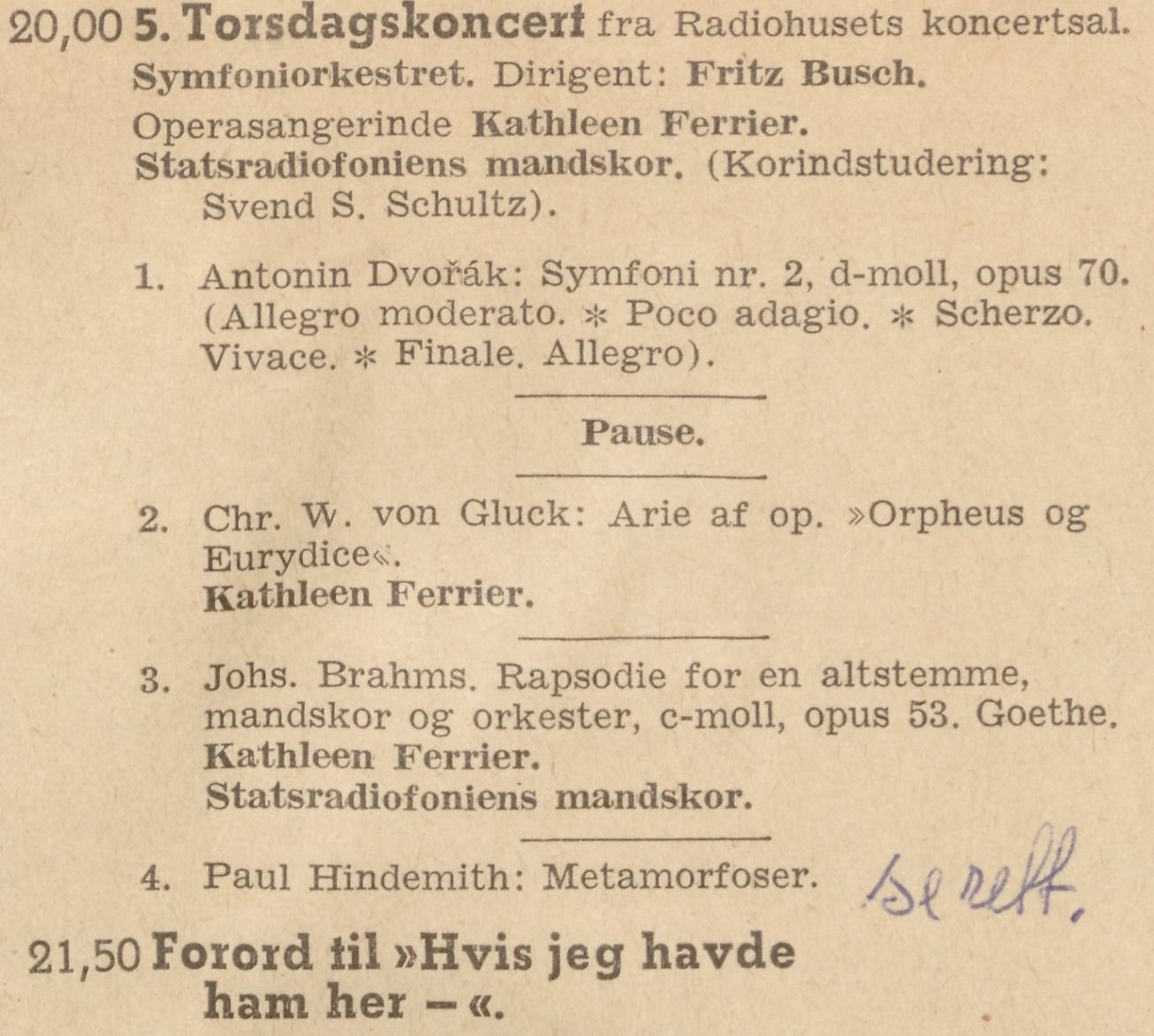
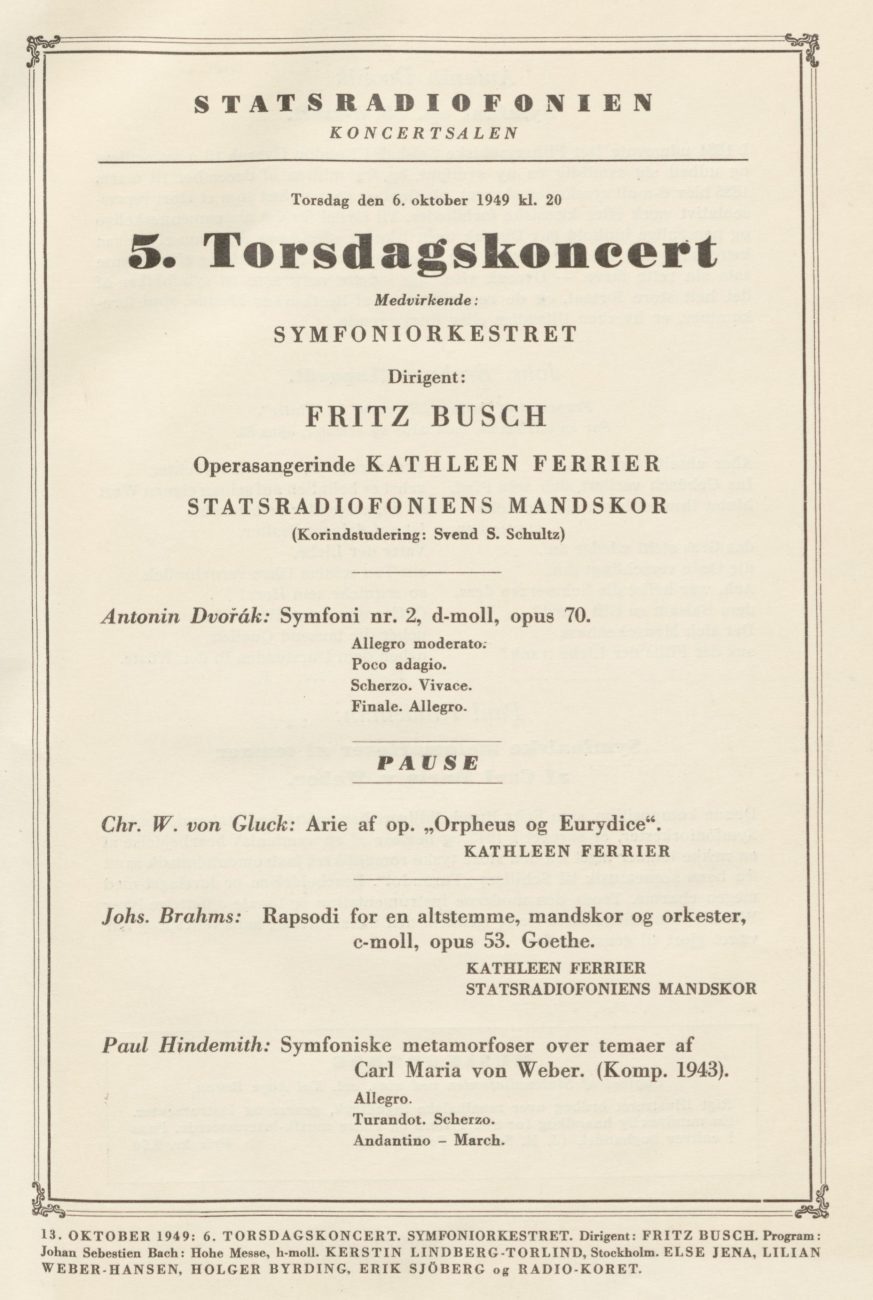
On voit que les deux Lieder de Brahms, probablement joués en bis, dans lesquels Ferrier est accompagnée par sa pianiste venue spécialement pour sa tournée en Scandinavie, ne figurent pas dans ce programme officiel. On les trouve par contre avec Gluck dans une feuille annexe de la Radio:

L’enregistrement de la Rhapsodie Op.53 a été complété par des sources provenant d’enregistrements privés de l’émission de la Radio Danoise pour compenser les parties dégradées de l’archive officielle. Les deux Lieder sont incomplets. Il manque les six premiers vers du premier Lied, et le début de l’introduction pianistique de l’autre.
Kathleen Ferrier et Fritz Busch se sont retrouvés avec l’Orchestre de la Radio Danoise au Festival d’Edimbourg, le 28 août 1950, avec le Royal Choral Union d’Edimbourg pour cette Rhapsodie Op.53.
Fritz Busch avait prévu de faire son grand retour à Berlin en mars 1952. A cette occasion, il avait invité Kathleen Ferrier à ses concerts qui devaient avoir lieu avec les 16 et 17 mars avec l’Orchestre de la RIAS. Sa disparition en septembre 1951 a réduit ce projet à néant.
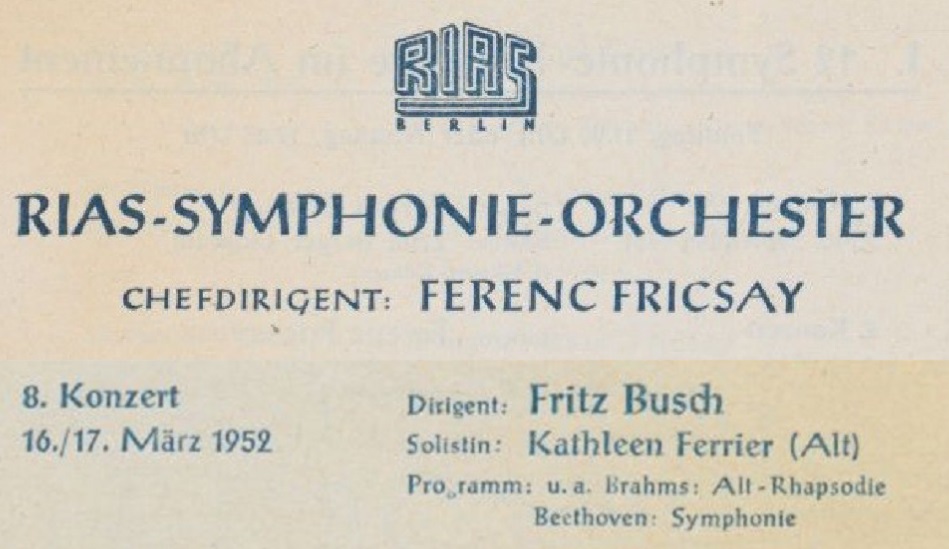
____________

____________
Within two days, Kathleen Ferrier offered us two major recordings.
To start with, in London where the Vienna Philharmonic (WPO) was present between 28 September to 6 October during a tour conducted by Furtwängler which later joined Paris, Geneva and Zürich.
Ferrier and Walter, back from d’Edinburgh, gave on October 1 and 2 two Mahler concerts in London with the Kindertotenlieder and the Second Symphony (BBC SO and Choral Society).
On the 4th, Furtwängler conducted a Brahms concert with Menuhin and the WPO, and an afternoon recording session (2.30pm – 5.30pm) has been set at Kingsway Hall to record the Kindertotenlieder with Bruno Walter.
Walter took the opportunity of being in London to conduct one concert with the WPO on the 6th. But it was without Ferrier who, on that very day, sang the ‘Alt-Rhapsodie’ with Fritz Busch in Copenhagen. Anyway, with the WPO in London, she might not have sung the work by Brahms : Furtwängler already put the ‘Alt-Rhapsodie’ at the program of his concert on 28 September (with Mary Jarred).
The programme conducted by Fritz Busch and his Orchestra of the Danish Radio was comprised of Dvorak’s Symphony n°7 Op.70 (then named ‘n°2’ as when it was published), and for the second part, Arias from Gluck’s Orpheus, then the Rhapsodie Op.53 by Brahms and to end with, Hindemith’s Metamorphosen:

We see that the two Brahms’Lieder, probably performed as encores, in which Ferrier is accompanied by her pianist who came especially for her Scandinavian tour, are not mentioned in this official programme. They are however found with the Gluck item in an extra Radio programme sheet:

The recording of the Rhapsody Op.53 was completed by private sources coming from the broadcast of the Danish Radio Danoise to compensate for the unusable parts of the official archive. Both Lieder are incomplete. The six first verses of the first Lied are missing, as well as the beginning of the piano introduction of the second.
Kathleen Ferrier and Fritz Busch met again with the Danish Radio Orchestra at the Edinburgh Festival on 28 August 1950, with the Edinburgh Royal Choral Union for this Rhapsody Op.53.
Fritz Busch scheduled his postwar return to Berlin for March 1952. He seized the opportunity for inviting Kathleen Ferrier to his concerts that were to take place on 16 and 17 March with the RIAS Orchestra. His death in September 1951 ruined this project.


Bruno Walter WPO Charles Kullman Kerstin Thorborg
Mahler: Das Lied von der Erde – Rückert Lied « Ich bin der Welt abhanden gekommen »
Wien Musikvereinsaal – «Live» 24 Mai 1936
Source: 33t/LP EMI Toshiba (Japan) EAC-57049
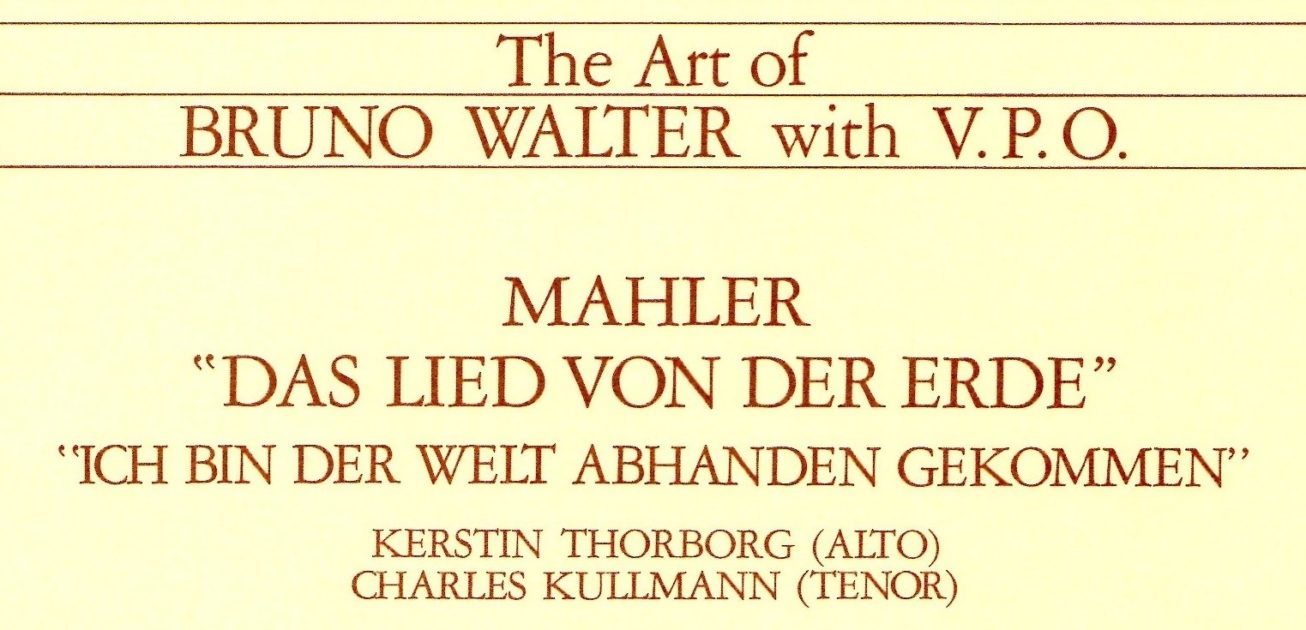
A l’occasion du 25ème anniversaire de la disparition du compositeur survenue le 18 mai 1911, Bruno Walter a dirigé trois concerts à Vienne.
Le premier a eu lieu le 22 mai dans les studios de la Radio (RAVAG) avec les Wiener Symphoniker et il a été diffusé en direct. Le programme comportait les Lieder eines fahrenden Gesellen avec Rosette Anday et la 9ème Symphonie:
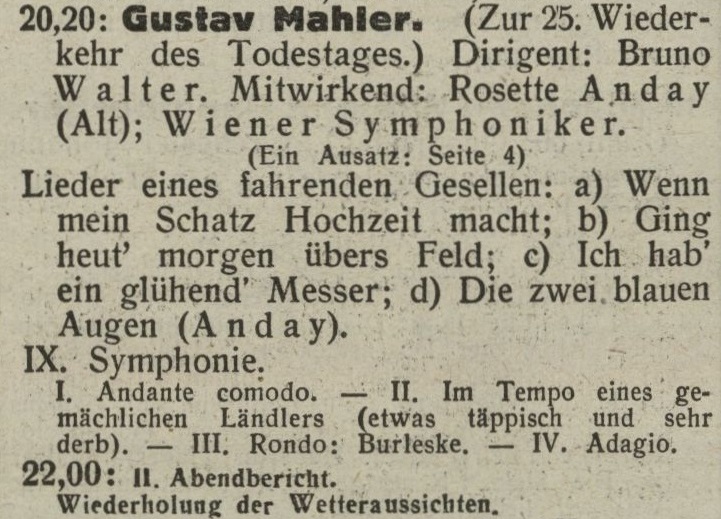
Les deux autres concerts ont été donnés les 23 et 24 mai à la Musikvereinsaal avec le WPO, Charles Kullmann et Kerstin Thorborg, avec au programme deux Rückert Lieder (Ich bin der Welt abhanden gekommen et Um Mitternacht), puis Das Lied von der Erde. Le deuxième concert a été enregistré par EMI et publié à l’exception d’ Um Mitternacht en un album ROX 165 à 171 de sept 78 tours (matrices CHAX 125 à 138) pour Das Lied von der Erde et un disque séparé LB45 (matrices CHA 744 & 745) pour le Rückert Lied.
N.B. :En 1939, Kullmann a modifié l’orthographe de son nom en Kullman.
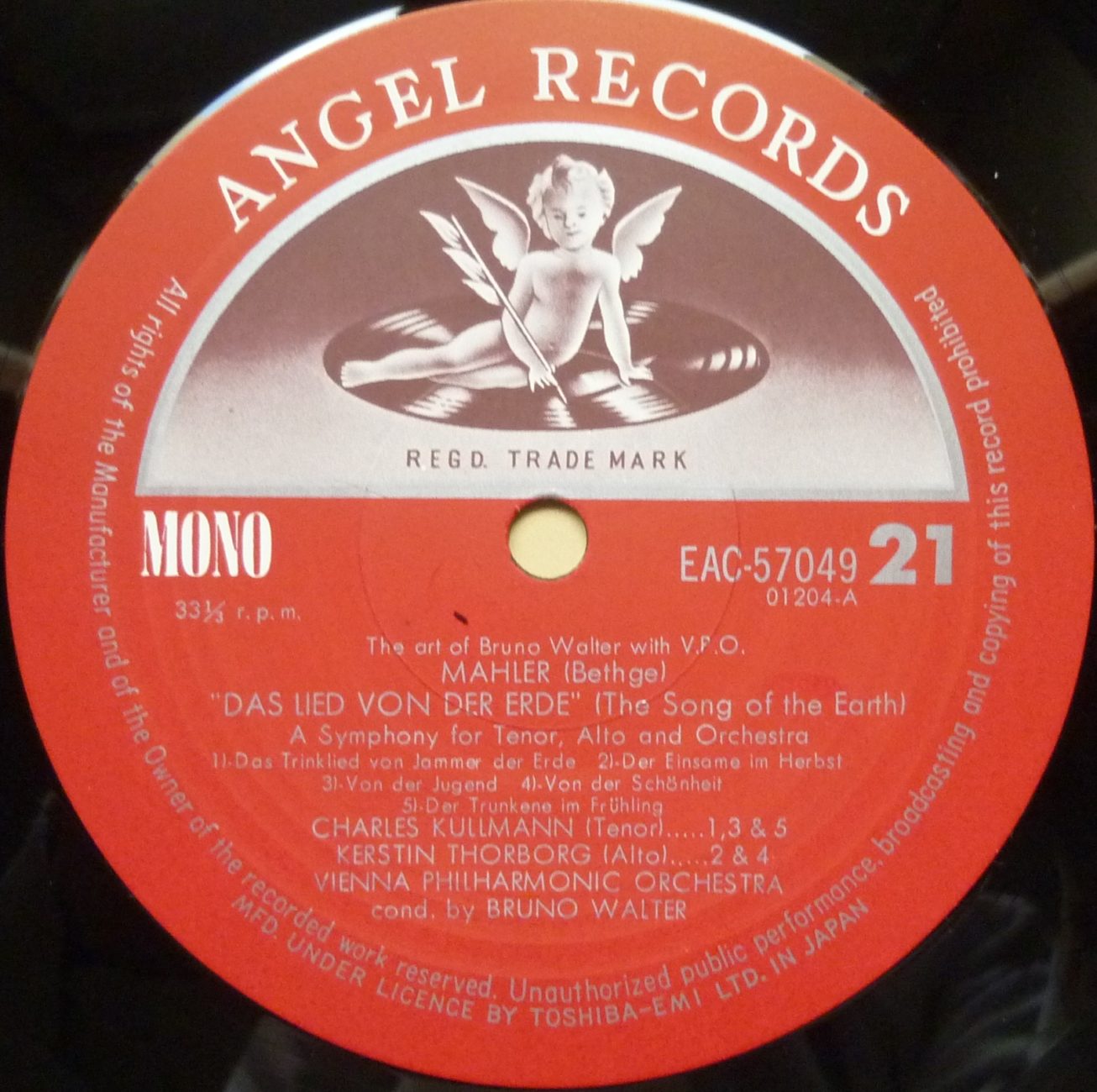

Le blog 33+45=78 qui était spécialisé dans le report de 78 tours avec un haut niveau de qualité a proposé l’enregistrement de Das Lied von der Erde avec le contenu non monté des faces 78 tours. On constate que, pour assurer une continuité sans accroc des faces 78 tours pour les Lieder (I, II, IV et VI) qui occupent plus d’une face, il y a un recouvrement de quelques secondes d’une face à l’autre.
Les fichiers mis en ligne par le site 33+45=78 sont malheureusement devenus introuvables suite à la fermeture de ce site remarquable. Ils vous sont proposés à titre de bonus.
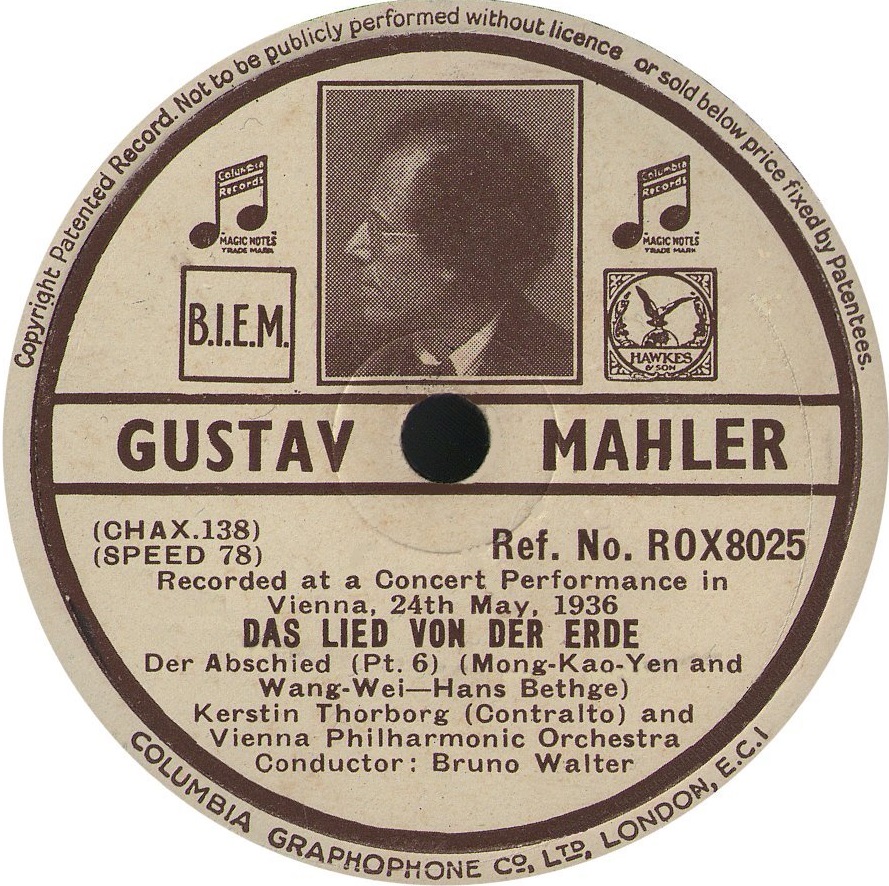
To celebrate the 25th Anniversary of the composer’s death on May 18, 1911, Bruno Walter conducted three concerts in Vienna.
The first one took place on May 22 in the studios of the Vienna Radio (RAVAG) with the Wiener Symphoniker and it was broadcast live. The program was comprised of the Lieder eines fahrenden Gesellen with Rosette Anday and of the Ninth Symphony:

The other two concerts took place on May 23 and 24 at the Musikvereinsaal with the WPO, Charles Kullmann and Kerstin Thorborg, with a program consisting of two Rückert Lieder (Ich bin der Welt abhanden gekommen and Um Mitternacht), and then Das Lied von der Erde. The second concert was recorded by EMI and published (without Um Mitternacht) as an album ROX 165 to 171 of seven 78rpm records for Das Lied von der Erde (matrix n°: CHAX 125 to 138) and a separate disc LB45 (matrix n° CHA 744 &745) for the Rückert Lied. .
N.B. :In 1939, Kullmann changed the spelling of his name into Kullman.
The blog 33+45=78 which made a speciality of high quality transfers of 78rpm records proposed the recording of Das Lied von der Erde with the unedited content of the 78rpm sides. One notes that, in order to obtain the best possible continuity between the 78rpm sides for the Lieder (I, II, IV et VI) that require more than one side, there is an overlap of a few seconds between the sides.
The files uploaded by the blog 33+45=78 are no longer available since this remarkable site closed. We propose them as a bonus.

Kerstin Thorborg Orpheus Salzburg 1936
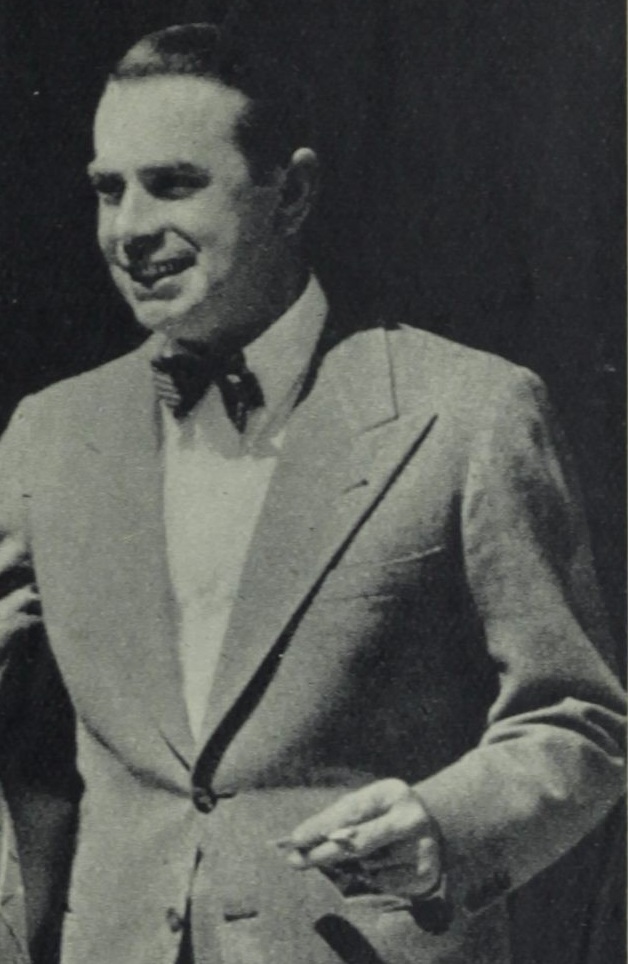
Charles Kullman Salzburg 1936
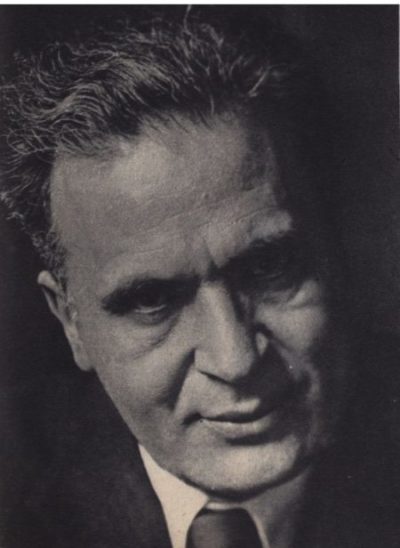
Walter – IV – Mahler Symphonie n°9 WPO
Musikvereinsaal – 16 Januar (Jänner) 1938
Source: 33t. Angel Japan « The Art of Bruno Walter with WPO »
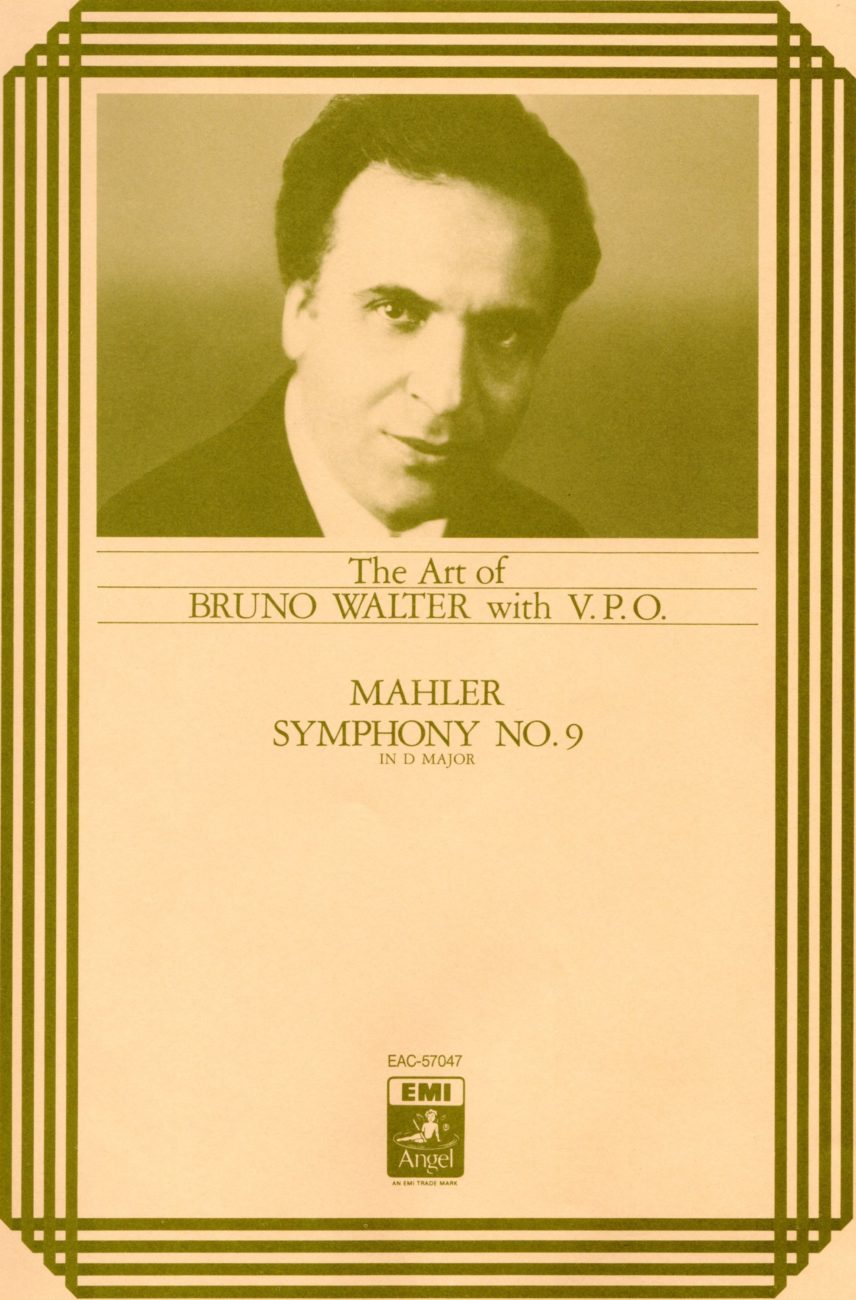
Cette interprétation mahlérienne à la fois intense et sobre, captée en public, est un document inestimable.
En janvier et février 1938, avant de partir comme chaque année à pareille époque depuis 1933 pour une série de concerts du 3 au 19 mars 1938 avec le Concertgebouworkest d’ Amsterdam, Bruno Walter a dirigé à Vienne des concerts au Musikverein et des représentations au Staatsoper, ainsi qu’un ultime concert à Budapest, selon le calendrier suivant:
6 Janvier Staatsoper: Bizet Carmen
8 Janvier Staatsoper: Verdi Don Carlos
15 & 16 Janvier Musikvereinsaal: Mozart Symphonie n°41 – Mahler Symphonie n°9
17 Février Staatsoper: Weber Oberon
19 & 20 Février Musikvereinsaal: Mendelssohn Sommernachtstraum Ouv. – Wellesz Prosperos Beschwörungen Op.53 – Bruckner Symphonie n°4 (3 ème Version 1888)
21 Février Budapest Theatre Erkel: Mozart Symphonie n°35 – Strauss Don Juan – Bruckner Symphonie n°4 (3 ème Version 1888)
26 Février Staatsoper: Smetana Dalibor (Nouvelle production de Lothar Wallerstein Première)
Cette représentation de Dalibor de Smetana sera la dernière prestation de Bruno Walter à Vienne avant l’Anschluss et son exil forcé.
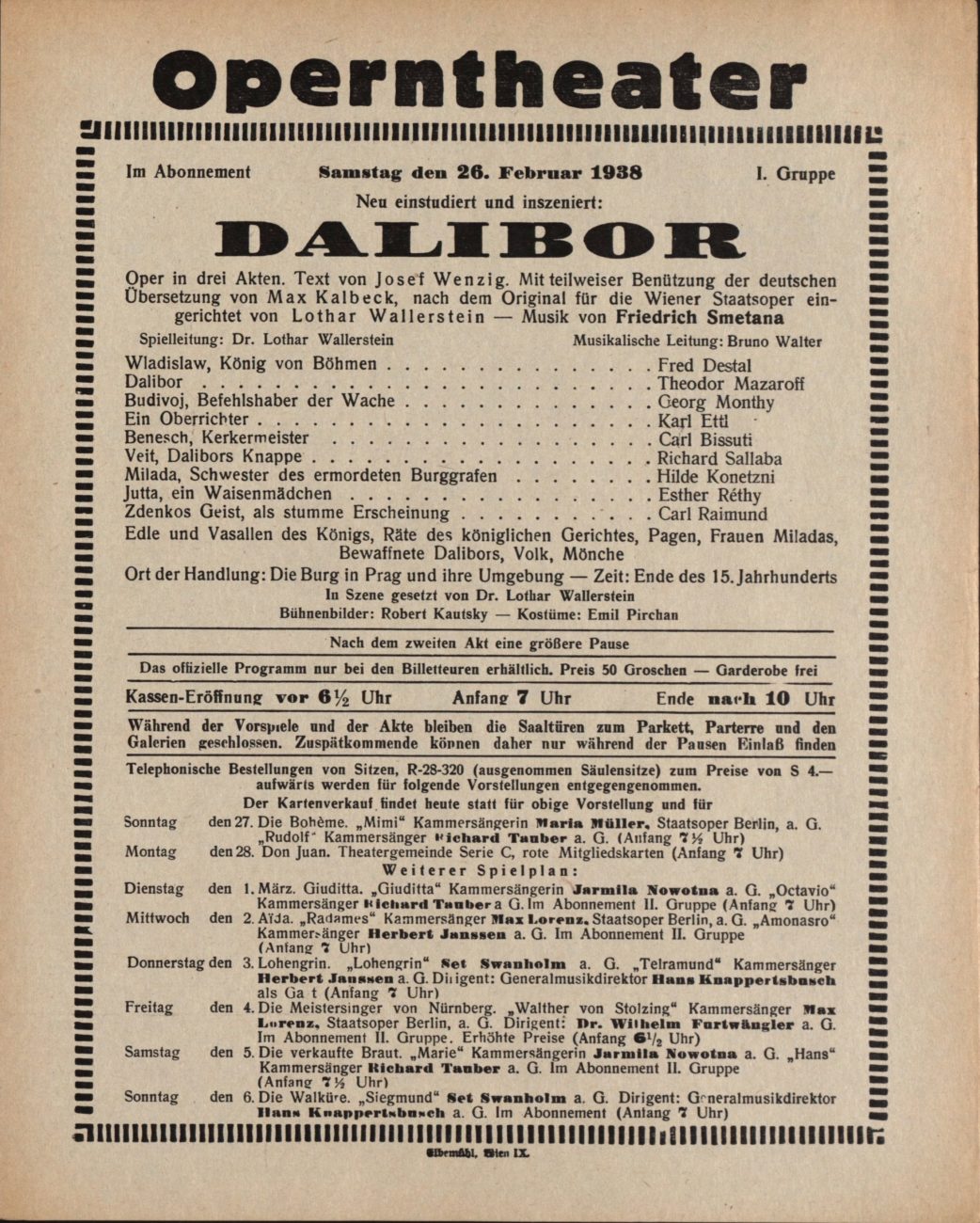
This intense and yet classical live recorded Mahler performance is an invaluable document.
In January and February, before leaving for Amsterdam like he did each year at the same period since 1933 for a series of concerts from 3 to 19 March 1938 with the Concertgebouworkest, Bruno Walter conducted in Vienna concerts at the Musikverein and at the Staatsoper, as well as a valedictory concert in Budapest, according to the following schedule:
January 6 Staatsoper: Bizet Carmen
January 8 Staatsoper: Verdi Don Carlos
January 15 & 16 Musikvereinsaal: Mozart Symphony n°41 – Mahler Symphony n°9
February17 Staatsoper: Weber Oberon
February 19 & 20 Musikvereinsaal: Mendelssohn Sommernachtstraum Ouv. – Wellesz Prosperos Beschwörungen Op.53 – Bruckner Symphony n°4 (3rd Version 1888)
February 21 Budapest Theatre Erkel: Mozart Symphony n°35 – Strauss Don Juan – Bruckner Symphony n°4 (3rd Version 1888)
February 26 Staatsoper: Smetana Dalibor (New production by Lothar Wallerstein Première)
This performance of Smetana’s Dalibor was to be Bruno Walter’s last performance in Vienna before the Anschluss and his forced exile.
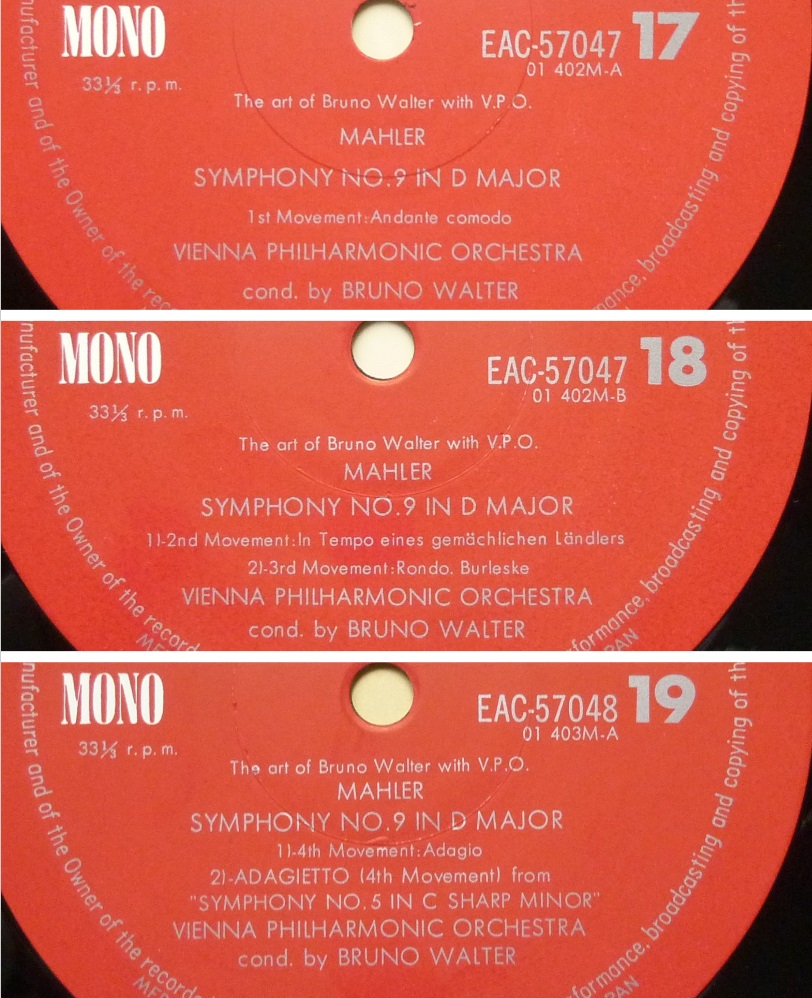

Mozart
Symphonie n°38 K.504 WPO Musikvereinsaal 18 Dezember 1936
Symphonie n°41 K.551 WPO Musikvereinsaal 11 Januar (Jänner) 1938
Source: 33t. Angel Japan « The Art of Bruno Walter with WPO »
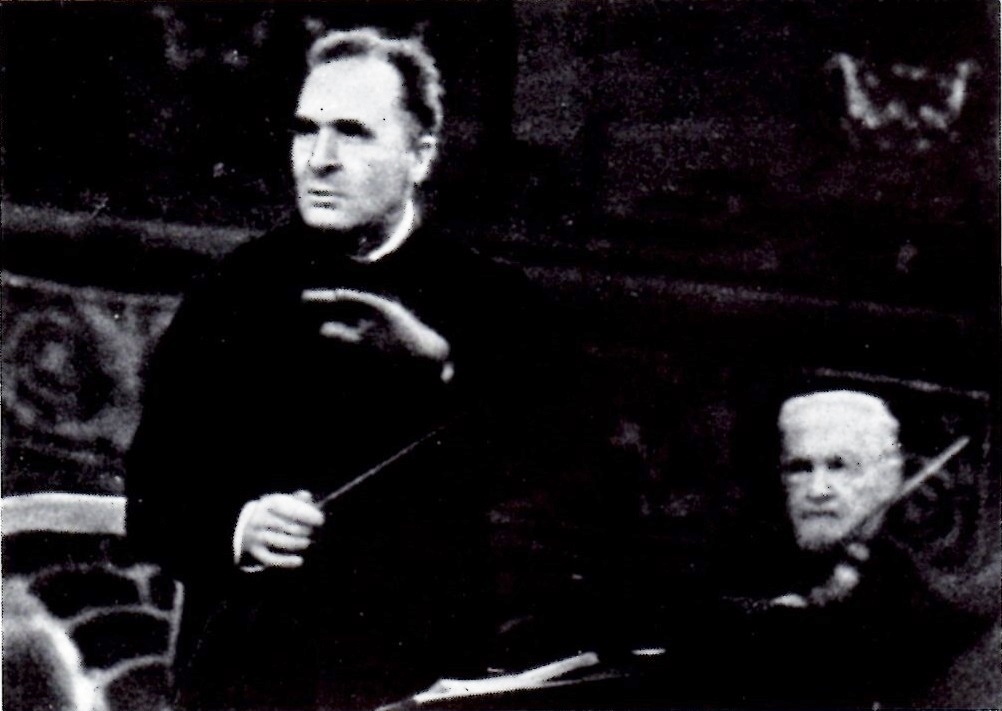
Bruno Walter & Arnold Rosé
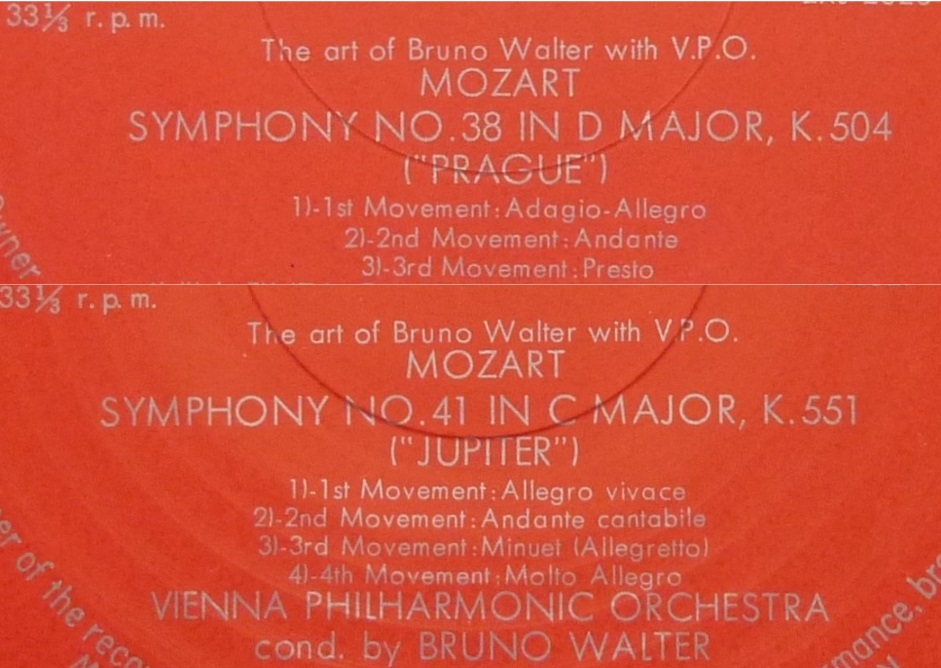
________
Sinfonia Concertante K.364 NYPO John Corigliano & William Lincer Carnegie Hall 10 March 1946 Source: Bande/Tape (origine: disques/transcription discs)
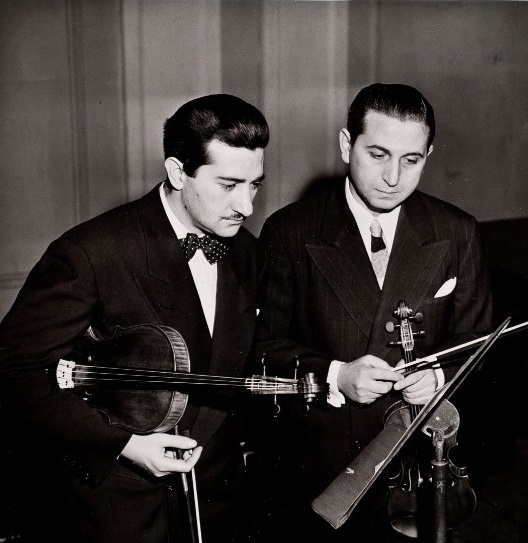
William Lincer & John Corigliano
________
Ces trois enregistrements de Bruno Walter représentent la fin de son activité à Vienne avant la guerre, la Symphonie n°41 accompagnant les 15 et 16 janvier la Neuvième de Mahler au cours de sa dernière série de concerts avant l’Anschluss, ainsi que son unique enregistrement accessible de la Symphonie Concertante pour violon et alto K.364 lors du concert du 10 mars 1946. Il avait déjà dirigé cette œuvre à New York les 5 et 6 mars 1925 avec en solistes Samuel Duskin et Lionel Tertis, et il l’a redonnée les 12 et 13 février 1953 avec Corigliano et Lincer, mais sans retransmission radiophonique à cette occasion. Un enregistrement de concert à Chicago (concert télévisé du 25 janvier 1956 avec John Weicher et Milton Preeves) a été recensé dans une archive privée, mais n’a pas été publié. Le concert du dimanche 10 mars 1946 est particulier en ce sens que son programme (Mozart K364, Brahms Symphonie n°4) est complètement différent de celui des concerts des 7 et 8 mars consacrés à la Passion selon St-Matthieu de Bach, alors qu’en général, le programme radiodiffusé le dimanche reprend en partie le programme de la semaine.
Concernant l’interprétation de la Sinfonia Concertante de Mozart, le critique Noel Straus écrivait: ‘John Corigliano, le concertmaster de l’orchestre, et William Lincer, son premier alto, ont été les solistes de l’opus de Mozart, qui, comme le Brahms, a bénéficié d’une lecture des plus élaborées et des plus élevées. Aucune interprétation ne peut être d’un esprit aussi complètement mozartien que celle qui a été donnée de la Sinfonia Concertante, une oeuvre unique en son genre qui n’a rien perdu de sa fraîcheur juvénile et de son grand attrait au cours des 167 années qui se sont écoulées depuis sa composition. Sous une direction moins, cette composition exquisément façonnée peut facilement dégénérer de la part des deux solistes en une exhibition de virtuosité. Même si une bravoure experte était apportée aux mesures en solo, la musique elle-même et la révélation de sa pleine signification étaient le souci principal de Mr. Walter, et il a montré que c’était possible sans exagérer la composante soliste, avec pour résultat qu’un parfait sens de l’équilibre, rarement obtenu dans cette oeuvre à l’orchestration légère, a été rendu possible. Avec cette manière de faire, la composition a gagné en intimité, et rien n’a été oublié pour projeter le caractère sensible et poétique de son contenu. L’art et la compétence technique de Mr. Corigliano et de Mr. Lincer étaient si complètement en harmonie, leurs sonorités si subtilement intégrées et équilibrées, que leurs jeux formaient remarquablement un tout, et s’inscrivaient en même temps dans le cadre dynamique qui convenait exactement à la fusion avec un accompagnement orchestral finement conçu. Il est difficile d’imaginer un rendu plus éloquent et plus convaincant, ou plus admirable par sa pureté tonale, la beauté de sa texture, par ses couleurs et par son expressivité.’
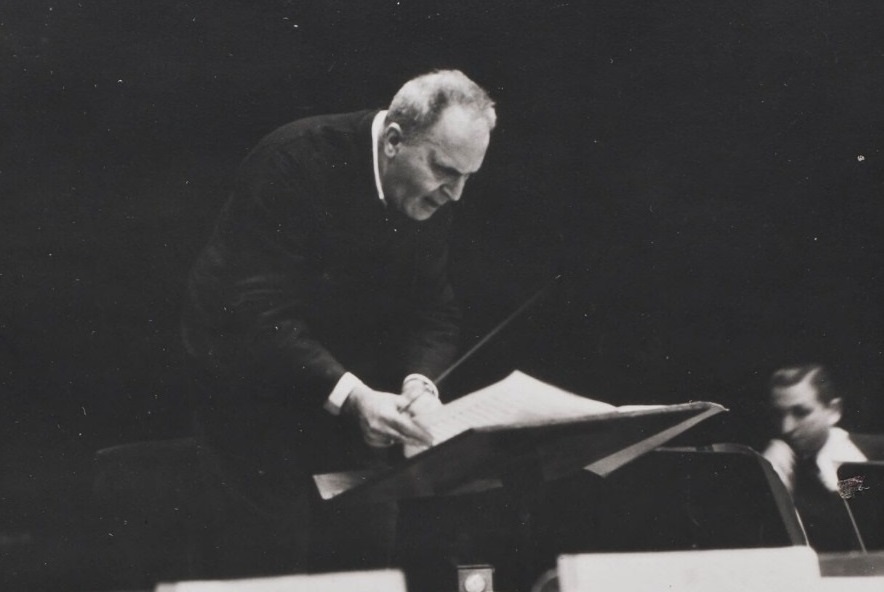
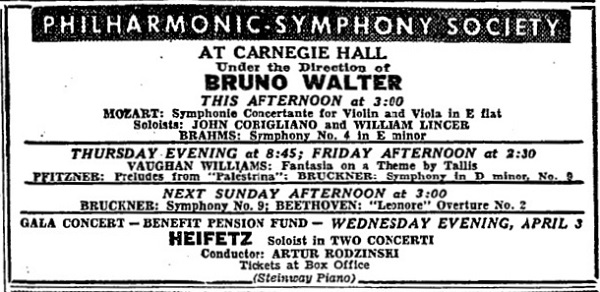
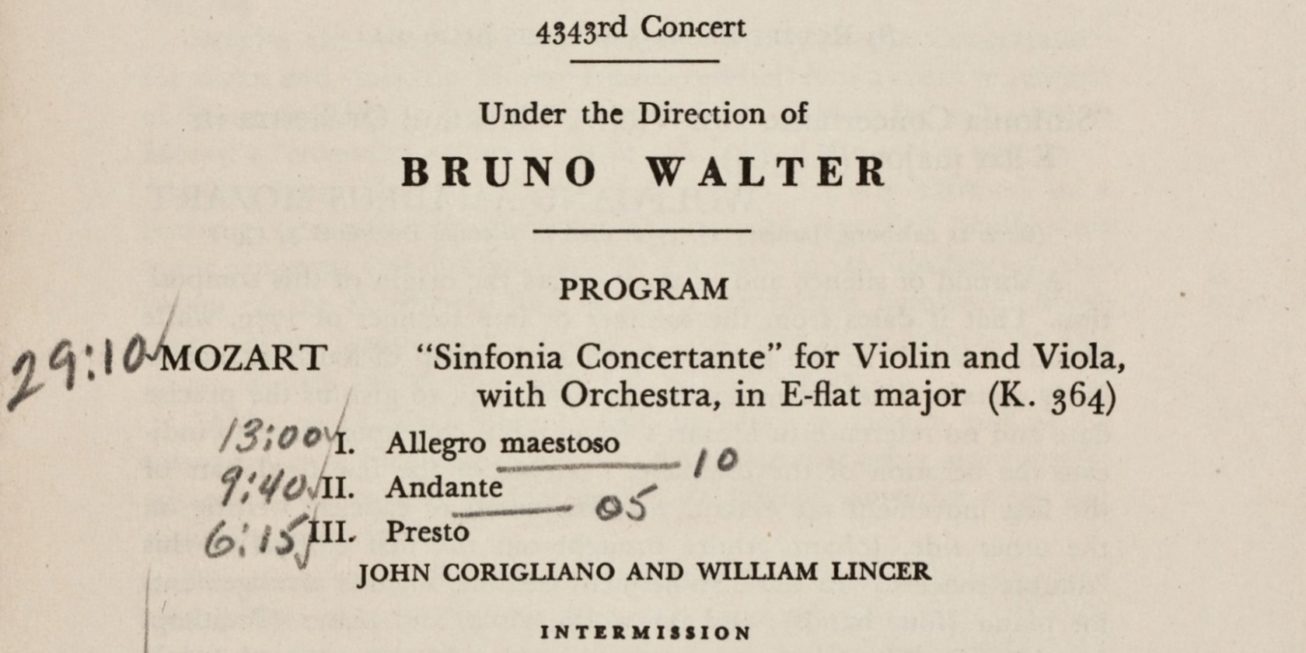
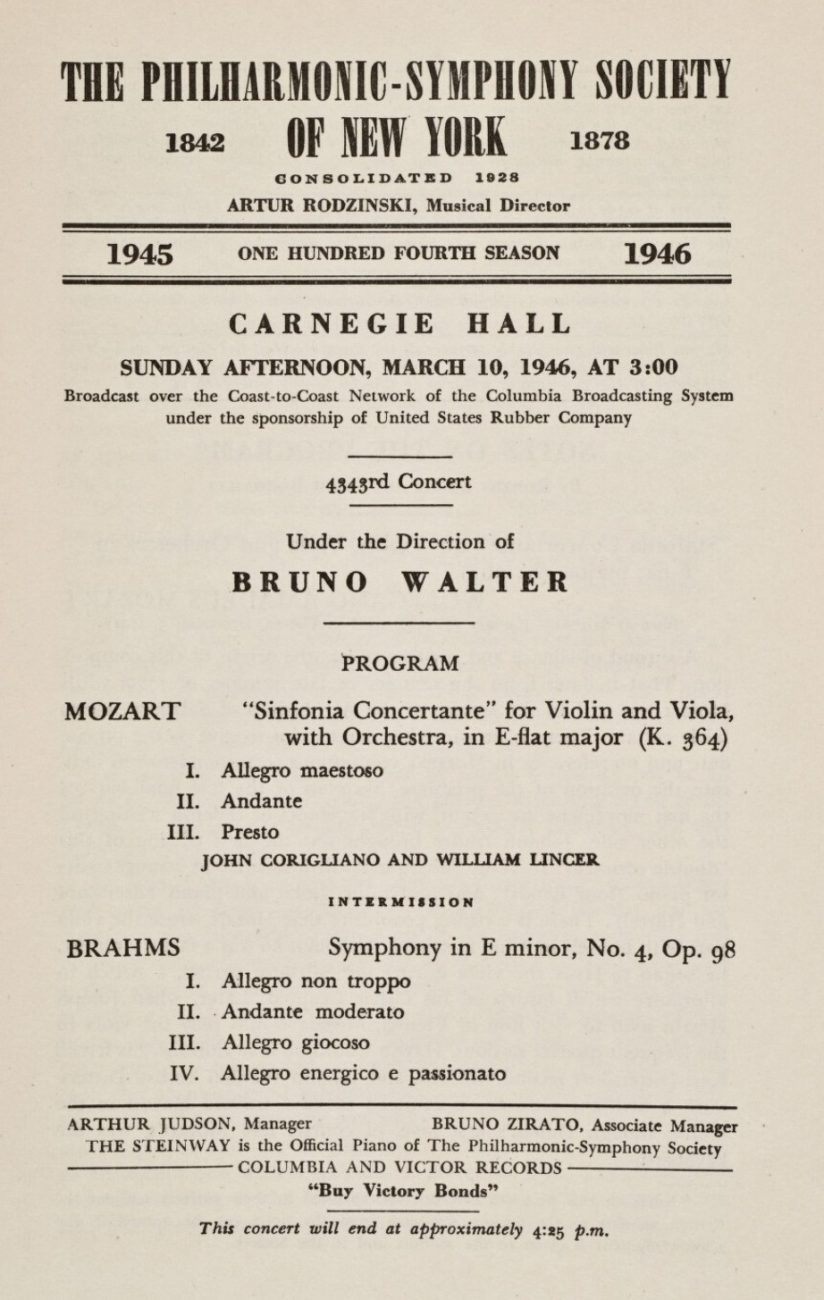
These three Bruno Walter recordings illustrate the end of his pre-war tenure in Vienna, the Symphony n°41 being played on the 15 and 16 January together with the Mahler Ninth during his last series of concerts there before the Anschluss, as well as his only available recording of the Sinfonia Concertante for violin and viola K.364 during the concert of March 10, 1946. He already conducted this work in New York on 5 and 6 March 1925 with Samuel Duskin and Lionel Tertis as soloists, and he performed it again on 12 and 13 February 1953 with Corigliano et Lincer, but without broadcast this time. A concert recording in Chicago (TV concert on 25 January 1956 with John Weicher and Milton Preeves) has been listed in a private archive, but hasn’t been published. The concert of Sunday 10 March 1946 is special in the sense that its program (Mozart K.364, Brahms Symphony n°4) is entirely different from the preceding ones on 7 and 8 March dedicated to Bach’s Passion according to St-Matthew, whereas usually, the program of the Sunday broadcast is partly comprised of works played during the week.
Concerning the performance of the Sinfonia Concertante by Mozart, music critic Noel Straus wrote: ‘John Corigliano, the orchestra’s concertmaster and William Lincer, its first viola, were the soloists in the Mozart opus, which, like the Brahms work, gloried in a reading of a most searching and exalted nature. No performance could be more completely Mozartean in spirit than that given of the Sinfonia Concertante, an unrivaled work of its genre that has lost nothing of its youthful freshness and deep appeal with the passage of the 167 years since its creation. Under less fully comprehending direction, the exquisitely wrought composition easily can become first and foremost an exhibition of virtuosity on the part of the two soloists. But for all the expertness of bravoura brought to the solo measures, the music itself and the revelation of its meaning to the full was the primary consideration with Mr. Walter and this he found possible without overstressing the solo element with the result that a perfect sense of balance, rarely achieved in this lightly orchestrated score, became possible. The composition gained in intimacy through this type of treatment, and nothing was left undone to project the sensitive, poetic character of its content. The artistry and skill of Mr. Corigliano and Mr. Lincer was so perfectly matched, their tone so subtly integrated and equalized, that their playing proved remarkably unified, and at the same time was held in just the right dynamic frame to blend absolutely with the finely considered orchestral support. It is difficult to conceive of a presentation of this work more eloquent and persuasive, or more admirable in tonal purity, beauty of texture, coloring and expressiveness.’

New York Philharmonic – Bruno Walter – Irmgard Seefried, soprano
Carnegie Hall – 4 janvier 1953
Source: Bande/Tape 38 cm/s / 15 ips
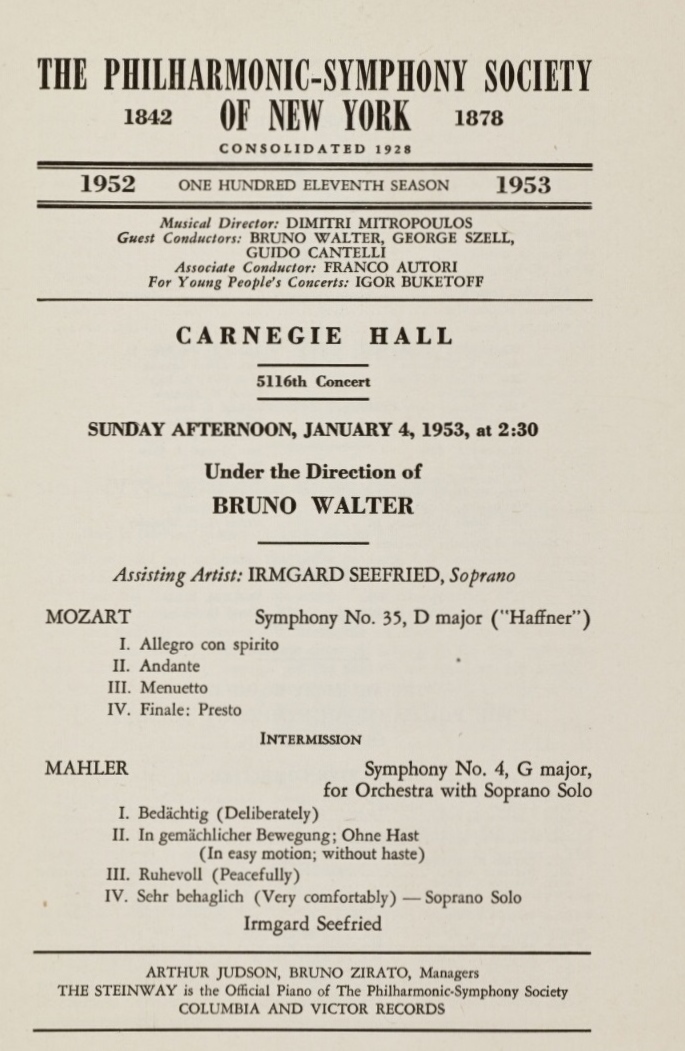

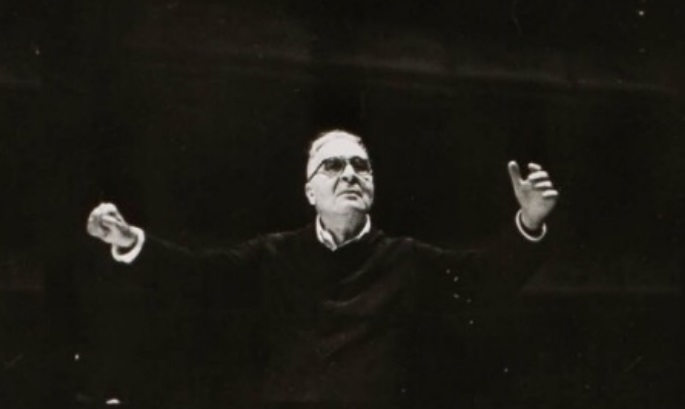
Irmgard Seefried a chanté pour la première fois avec Bruno Walter au Festival de Salzburg 1950, les 23 et 24 août, avec au programme cette même Quatrième Symphonie qu’elle a aussi donnée sous sa direction au Festival d’Edinburgh le 22 août 1951 lors de son tout premier concert avec le NYPO. Sa première apparition à New York a été un récital à Town Hall le 9 décembre 1951 avec Paul Ulanowsky, lors de sa première tournée américaine.
Le concert radiodiffusé du dimanche 4 janvier ne comportait pas les mêmes œuvres que les deux précédents, donnés les 1er et 2 janvier* qui proposaient quatre Lieder avec orchestre de Mahler (Ich bin der Welt abhanden gekommen, Wo die schönen Trompeten blasen, Ich atmet’ einen linden Duft, Wer hat dies Liedlein erdacht), des premières pour le NYPO, dont on n’a hélas pas l’enregistrement, ce qui est d’autant plus regrettable que ce sont les seuls concerts où Seefried et Walter les ont programmées:
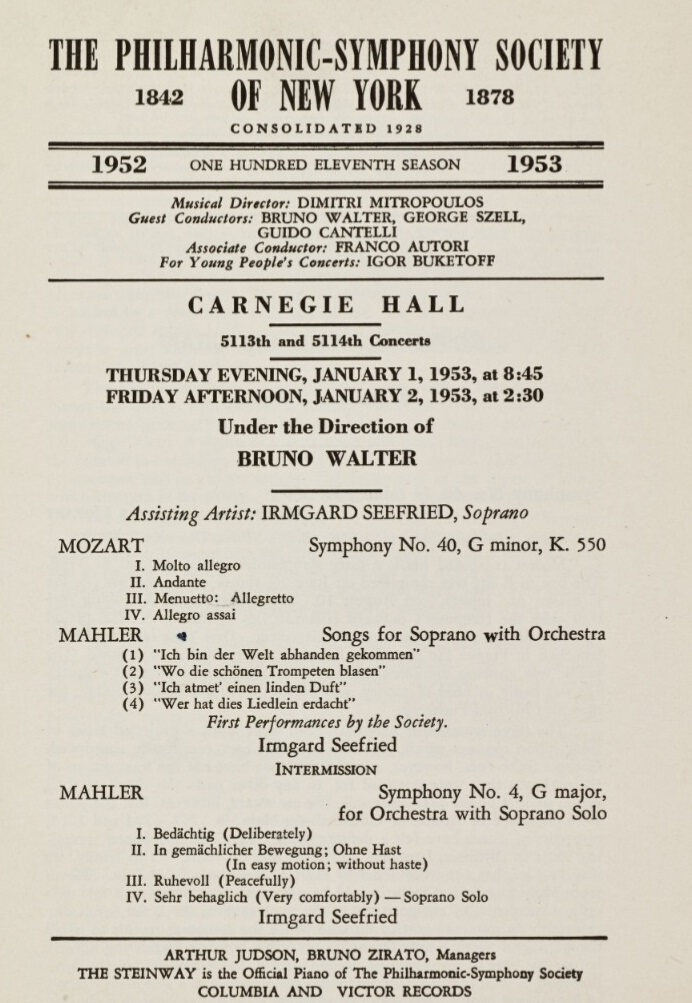
* le concert du 3 janvier 1953 a été dirigé par Franco Autori avec un tout autre programme (Debussy Cathédrale Engloutie, Beethoven Concerto n°5 Eugene Istomin, Sibelius Symphonie n°2).
§§§§§
Seefried a déclaré en 1982 dans une interview: « J‘ai appris de Bruno Walter le style de Mahler. Il m’a dit que Mahler était quelqu’un de très sérieux et de très strict, qu’il fallait le chanter de manière claire et classique, et que pour le Final de la Quatrième, je devais avoir le sentiment d‘être un petit ange chérubin avec une petite trompette, alors que la plupart des sopranos le font comme une petite berceuse ».
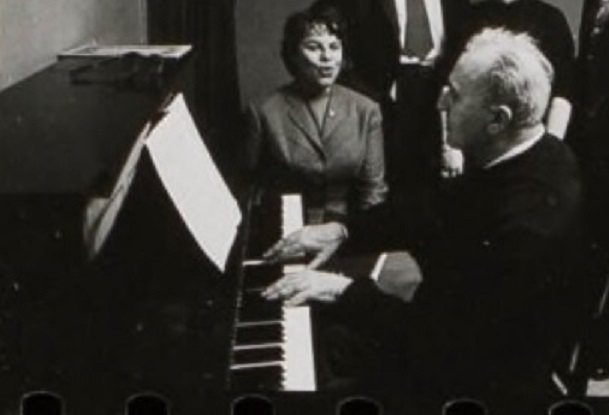
Il reste à expliquer pourquoi, lors du concert du dimanche, la Symphonie n° 35 « Haffner » de Mozart (17′) a été jouée au lieu des quatre mélodies de Mahler (durée totale 15′) qui auraient été le choix logique. L’explication est qu’une séance d’enregistrement était programmée le lundi 5 janvier, dans les Studios Columbia avec la Symphonie « Haffner » et …… « Siegfried Idyll » de Wagner. Il n’est guère étonnant qu’au vu de la charge de travail de l’orchestre en ce début d’année, la séance du 5 janvier ait été peu productive et que l’essentiel de ce qui a été publié provienne de la séance supplémentaire programmée à la hâte le 16 janvier (Mozart Symphonie n°35: 16 janvier; Wagner Siegfried Idyll: 5 & 16 janvier), organisée alors même que l’orchestre donnait ce jour-là en début d’après-midi un concert sous la direction de George Szell.
____________
Irmgard Seefried sang for the first time with Bruno Walter at the 1950 Salzburg Festival, on August 23 and 24, and it was this Fourth Symphony which she also sang under his direction at the Edinburgh Festival on August 22, 1951 for her very first concert with the NYPO. During her first US tour, she was heard at a Town Hall recital with Paul Ulanowsky on December 9, 1951, and this was the first time she sang in New York.
The Sunday January 4 broadcast was not comprised of the same works as the two other ones on January 1 and 2* which proposed four Mahler orchestral Lieder (Ich bin der Welt abhanden gekommen, Wo die schönen Trompeten blasen, Ich atmet’ einen linden Duft, Wer hat dies Liedlein erdacht), first performances with the NYPO, and there is unfortunately no recording thereof, which is all the more regrettable since these were the only concerts at which Seefried and Walter performed them.
* the January 3, 1953 concert was conducted by Franco Autori with an entirely different program (Debussy Cathédrale Engloutie, Beethoven Concerto n°5 Eugene Istomin, Sibelius Symphonie n°2).
§§§§§
In a 1982 interview, Seefried declared: « I learned the style of Mahler from Bruno Walter. He told me that Mahler was somebody very serious, very strict, that he had to be sung in a clear and classical way, and that for the Final movement of the Fourth, I was to have the feeling of being a tiny Cherubino angel with a tiny trumpet, whereas most sopranos do it as a little lullaby« .
There remains to explain why, at the Sunday broadcast concert, Mozart’s Symphony n° 35 « Haffner » (17′) has been played instead of the four Mahler Lieder (total timing:15′) which would have been the logical choice,. The reason was that a recording session had been scheduled on Monday January 5) at the Columbia Studios with the « Haffner » Symphony and…… Wagner’s « Siegfried Idyll ». Small wonder that, in view of the orchesta’s workload on this first week of 1953, the January 5 session had not been very successful, and that the major part of what has been published came from the hastily organized additional session on January 16 (Mozart Symphony n°35: January 16; Wagner Siegfried Idyll: January 5 & 16) scheduled although the orchestra was giving that very day an afternoon concert with George Szell.
Les liens de téléchargement sont dans le premier commentaire. The download links are in the first comment.



